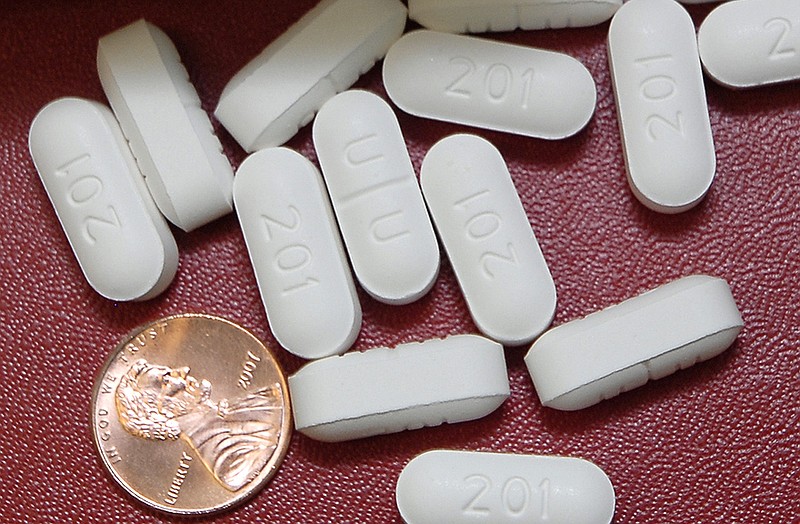Opioid misuse has accounted for an influx of hospitalizations over the past decade on national, state and local levels, according to a recently released Missouri Hospital Association (MHA) study.
Pain relievers, or opioids, commonly prescribed are oxycodone, hydrocodone, codeine and morphine, and they can be highly addictive, the study states, with three of four prescription pill users eventually becoming addicted to heroin - a less pricey alternative. In Missouri, inpatient hospitalizations and emergency room visits for opioid overuse has more than doubled from 2005-14.
This figure jumped from 187 hospitalizations per 100,000 people to 424 per 100,000 in 2014 in Missouri - a 137 percent increase, according to the study. In the years between 2006 and 2012, the state experienced the most dramatic increases with 12 percent more hospitalizations year to year. Nationally, the Centers for Disease Control and Prevention considers opioid overuse an epidemic. Since 1999, prescription opioid overdose deaths in the U.S. have quadrupled.
Mid-Missouri is no exception to seeing more hospitalizations due to the misuse of these drugs. Of a 10-county region (with Boone County as the most northern point, Camden County as southern, Gasconade County as eastern and Morgan as western), the overall increase in the opioid misuse hospitalization in the past decade was 106 percent at a rate of 290 hospitalizations per 100,000 people.
Mat Reidhead, MHA vice president of research and analysis, said Boone County's opioid misuse is growing at an "alarming" rate with a 194 percent increase, nearly tripling in the past 10 years. Cole County numbers, he said, are surprising, but for the opposite reason - a recorded lower rate of increase at 37 percent.
Dr. Karl Haake, a Jefferson City Medical Center pain management specialist, said patients and doctors alike need more education on pain and its treatment. Patients, he said, need to understand the dangerous magnitude of prescribed opioids and their potential effects. There are two types of pain - acute and chronic - which should be treated differently, Haake said. The source of pain must be removed or fixed with acute pain, caused by conditions like a broken arm, surgery, giving birth, etc.
Patients who feel ongoing pain for more than three months, Haake said, are enduring chronic pain. Current medications are not always effective in cases of chronic pain, but it's been popular practice to prescribe pills in the hopes pain will disappear. Those with a history of depression and anxiety are most at risk for developing an addiction, he said, adding their psychological pain "magnifies" their physical pain.
In ideal situations, doctors would be able to identify patients who are at risk for chronic pain and treat the underlying factors, like mental illness, but that's a challenge to do in an office setting and doctors lack mental health resources, Haake added. Through the Missouri Primary Care Association, Haake is leading an initiative to educate physicians about ways to better treat pain on a case-by-case basis as every one experiences pain differently. Hospitals tend to have patients rate their pain on a 1-10 scale, and levels of pain vary by the patient.
Therefore, he said the pain source must be pinpointed before writing prescriptions or advising treatment. For example, Haake said patients with lower back pain may need surgery, an injection or exercise depending on the pain severity.
"The treatment of pain is so individualized and that's the hard part for physicians because sometimes we want just a one-size-fits-all treatment for whatever ails us, and it just cannot be that way with pain," Haake said. "By trying to make it that way, that's where we run into problems with these prescription abuses, overdose deaths and hospitalizations."
Sarah Gonzalez, program director at McCambridge Center for women and children in Columbia, said she sees many women becoming addicted to opioids after giving birth or going through surgeries. At the center, women undergo therapy, medical visits and substance abuse education. About 3-4 years ago, Gonzalez said she scheduled clients at the center and noticed more coming into the residential facility with heroin and needle use from St. Louis and Kansas City.
"I knew it was a matter of time before it was right here," she said.
Since, Gonzalez said she's seen a steady increase of opioid and heroin-addicted clients. Many without health insurance will go to urgent care facilities and emergency rooms for quick fixes, being prescribed their drug of choice, she said, adding that opioids are also sometimes psychologically comforting for those addicted.
"I think people are, perhaps, self medicating and so it might not be an addiction to the medication itself, but the idea that it's helping, that they need it to get through the day," Gonzalez said. "So, it quickly becomes habit forming, and they're taking it and they're taking it more than prescribed because as prescribed didn't work..."
Clients advocate for their health by doctor shopping, she added. Because they tend to fill prescriptions at multiple pharmacies, Gonzalez said clients will also tell certain pharmacies not to distribute opioids to them.
She said she would like to see Missouri establish a prescription drug monitoring system in which pharmacies and physicians are able to communicate with each other. The Missouri legislature filed multiple bills in its 2015 session to establish a drug monitoring program, all of which died.
Haake said a monitoring system cannot be used to "fire" or disengage patients from their doctors and must be utilized as a way to "prescribe safer and care coordination."
"We can have the best prescription drug monitoring program that money can buy ... but if physicians and health care providers don't use it, it's worthless," he said. "We can pass that legislation, but if no one uses it to take better care of patients, it's useless."

